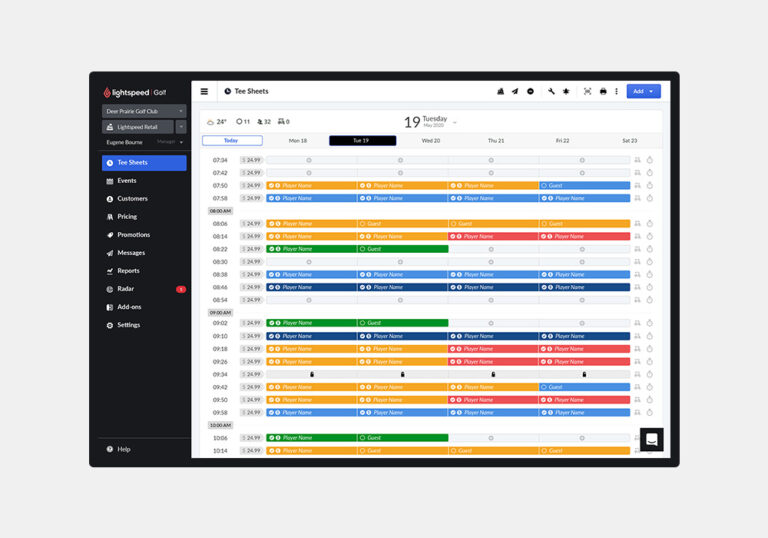Building a golf course can cost between $1.4 million to over $6 million. This wide range depends on numerous factors such as location, design, and land costs.
Delving into the world of golf course construction reveals a fascinating blend of art, science, and finance. Investors and developers must consider the intricate details of course design, environmental impact, and the market demand for new courses. Each hole on a golf course is a unique project, with costs that can vary dramatically based on the terrain and the desired level of sophistication.
Before breaking ground, meticulous planning ensures that every dollar is well spent, aiming to create a challenging yet enjoyable experience for golfers. The final cost includes not only the land and design but also the construction of clubhouses, maintenance facilities, and the installation of irrigation systems. Understanding the cost elements is crucial for those dreaming of bringing a new golf course to life.
Contents
- 1 The Dream Of A Golf Course
- 2 Initial Planning And Design Costs
- 3 Land Acquisition And Preparation Expenses
- 4 Construction And Development Outlay
- 5 Irrigation System Investment
- 6 Clubhouse And Facilities Construction
- 7 Ongoing Maintenance And Operational Costs
- 8 Marketing And Membership Strategies
- 9 Navigating Legal And Environmental Regulations
- 10 Financial Analysis And Funding Options
- 11 Real Stories: Case Studies Of Golf Course Construction
- 12 Conclusion: Is Building A Golf Course Worth It?
- 13 Frequently Asked Questions
- 14 Conclusion
The Dream Of A Golf Course
Many dream of building their own golf course. It symbolizes luxury, leisure, and a personal touch in the sport. This dream is big but achievable with the right planning and budget.
Why Build A Golf Course?
Building a golf course presents unique advantages:
- Customization: Tailor every hole and fairway to your vision.
- Prestige: Owning a golf course boosts your status.
- Control: You decide who plays and when.
Golf Course Types And Their Appeal
Different types of golf courses attract different people:
| Type | Features | Appeal |
|---|---|---|
| Private | Exclusive access, high-end amenities | Attracts elite players |
| Public | Open to all, affordable | Welcomes diverse groups |
| Resort | Luxury facilities, scenic views | Draws tourists and casual players |
Initial Planning And Design Costs
Embarking on the journey of building a golf course involves significant financial investment. Initial planning and design are critical phases that shape the project’s scope and budget. Understanding these costs is vital for any developer or investor.
Selecting The Site
Finding the perfect location is the first step. The site selection process involves:
- Land acquisition costs which vary by region and accessibility.
- Assessing the land’s topography to estimate construction ease and costs.
- Environmental impact studies to ensure sustainability and compliance.
Hiring A Golf Course Architect
A skilled architect turns vision into a playable design. This stage includes:
- Researching and selecting a qualified architect with a proven track record.
- Negotiating fees based on project size and complexity.
- Collaborating on a master plan that aligns with your budget and goals.
Design Complexity And Features
The design details influence the final costs significantly. Key considerations include:
| Feature | Impact on Cost |
|---|---|
| Holes | More holes, higher costs. |
| Water features | They add beauty and challenge, but increase expense. |
| Bunkers and hazards | Complexity elevates construction costs. |
| Green technology | Sustainable choices can save money long-term. |
Land Acquisition And Preparation Expenses
Embarking on the journey to build a golf course involves significant investment. Land acquisition and preparation are foundational steps in this process. Understanding these costs is crucial for a successful launch.
Purchasing The Land
The first step in creating a golf course is buying the right piece of land. This cost varies widely based on location, size, and land value. Key factors include:
- Location: Prime areas command higher prices.
- Size: More acres usually mean more money.
- Land value: Costs depend on the market.
Securing a suitable spot is essential for a course’s success. Buyers must consider accessibility, surroundings, and potential for development.
Landscaping And Terrain Shaping
Once the land is acquired, transforming it into a golf course begins. This stage is about creating the course’s physical features. Important aspects include:
- Design: Professional input ensures a challenging layout.
- Earthmoving: Heavy machinery shapes the terrain.
- Grassing: Selecting the right turf is vital.
Costs here depend on the complexity and design specifications of the course. Expert landscaping can significantly enhance the playing experience.
Soil Analysis And Remediation
Healthy turf starts with good soil. Experts must test the soil to ensure it can support lush greens. Factors to consider:
- Soil tests: Identify nutrients and pH levels.
- Amendments: Improve soil with organic materials.
- Drainage: Essential for turf health and playability.
Adjusting soil properties to meet agronomic standards can be costly. It’s a crucial step in building a sustainable golf environment.
Construction And Development Outlay
Embarking on the journey of building a golf course involves a significant investment, with the Construction and Development Outlay being the foundation of this financial venture. Understanding the costs tied to infrastructure, turfgrass, and on-course structures is crucial for accurate budgeting and successful completion of the project.
Infrastructure And Drainage Systems
A robust infrastructure and drainage system is vital for any golf course. Effective drainage ensures playability, even after heavy rains. Initial outlays include:
- Land grading to shape the course
- Drainage installation, crucial for turf health
- Irrigation systems to maintain greenery
Costs vary greatly, ranging from $50,000 to over $1 million, depending on course size and system complexity.
Turfgrass Selection And Planting
Selecting the right turfgrass is a balance of aesthetics, climate, and playability. Expenses include:
- Soil testing to determine nutrient needs
- Grass variety that suits the local climate
- Planting or sodding the chosen grass
Expect to invest $0.30 to $1.50 per square foot, influenced by grass type and labor costs.
Building On-course Structures
On-course structures such as clubhouses, rest areas, and maintenance buildings are necessary. Key expenses cover:
- Architectural design fees
- Building materials and labor
- Interior furnishings and amenities
Construction costs can range from $200 to $500 per square foot, greatly influenced by design complexity and materials chosen.
Irrigation System Investment
Investing in an irrigation system is a crucial part of building a golf course. It ensures lush greens and fairways. Let’s dive into the costs associated with this vital component.
Water Source And Storage Solutions
Finding the right water source is the first step in irrigation. Golf courses need a lot of water. Costs can vary widely. You might use city water, wells, or nearby lakes. Each option has different price tags.
- City water is reliable but often the most expensive.
- Well water reduces costs but requires drilling.
- Lake water is cheaper but needs treatment.
Storage is also key. Large tanks or reservoirs will be necessary. These can be above or below ground. Costs here include the containers and the land to place them on.
Irrigation Technology And Installation
Modern irrigation systems use advanced technology. They save water and money over time. Choosing the right system affects the initial investment.
| Feature | Benefit | Estimated Cost |
|---|---|---|
| Sensors | Monitor moisture | $$$ |
| Smart Controllers | Adjust watering automatically | $$$$ |
| Sprinkler Heads | Even distribution | $$ |
Installation is a big part of the cost. Professionals must design and install the system. They ensure efficiency and coverage. You’ll pay for labor, materials, and equipment.
Remember, good irrigation pays off. It keeps your golf course green and playable. Plan your budget carefully for this critical investment.
Clubhouse And Facilities Construction
Building a golf course involves more than just the fairways and greens. The clubhouse and supporting facilities are the heart of the golfing experience. These structures provide comfort, convenience, and luxury to the sport. Let’s dive into the costs and design considerations for these essential components.
Designing The Clubhouse
Designing a clubhouse blends aesthetics with functionality. Architects must consider the course’s theme, the expected foot traffic, and the local climate. These factors influence the cost significantly. On average, construction can range from $1.5 to $3.5 million. This cost covers basic design, materials, labor, and landscaping.
- Architectural fees: 8-12% of the construction cost
- Interior design: Depends on the level of luxury
- Landscape architecture: 4-6% of the outdoor space cost
Amenities And Recreational Areas
A golf course’s amenities enhance the player’s experience. These include pro shops, locker rooms, lounges, and dining areas. Recreational spaces might feature pools, tennis courts, and fitness centers. Each amenity adds to the total cost and requires careful planning.
| Amenity | Cost Estimate |
|---|---|
| Pro Shop | $250,000 – $500,000 |
| Locker Rooms | $200,000 – $400,000 |
| Swimming Pool | $150,000 – $300,000 |
| Tennis Courts | $50,000 – $100,000 each |
| Fitness Center | $100,000 – $300,000 |
Remember, these figures are estimates. The actual costs vary based on size, quality, and location. The key is to balance the desired amenities with the budget available.
Ongoing Maintenance And Operational Costs
The initial layout of a golf course might capture the spotlight, but the ongoing maintenance and operational costs keep the greens in top condition. These expenses are crucial for the enduring appeal and playability of the course.
Staffing Requirements
Skilled personnel are the backbone of any golf course. A team of groundskeepers, pro shop staff, and hospitality crew ensure smooth operations.
- Groundskeepers maintain course quality.
- Pro shop staff manage inventory and sales.
- Hospitality crew enhance player experience.
Equipment And Supplies
Maintaining a golf course demands high-grade equipment and supplies. These range from mowers to fertilizers, all significant in keeping the course pristine.
| Item | Frequency | Cost Estimate |
|---|---|---|
| Mowers | Weekly | $500-$1000 |
| Fertilizers | Monthly | $200-$400 |
| Watering Systems | Daily | $100-$300 |
Long-term Maintenance Planning
For sustainability, golf courses require long-term maintenance planning. This includes renovations, restorations, and upgrades.
- Analyze current course conditions.
- Forecast future maintenance needs.
- Set aside funds for unexpected repairs.
Marketing And Membership Strategies
Delving into the golf industry requires a strategic approach to attract members and establish a reputation. A well-planned marketing and membership strategy can make or break the success of a new golf course. Let’s explore the key elements.
Creating A Brand Identity
A strong brand identity resonates with potential members. It sets the tone for the entire golfing experience. Start by defining your golf course’s unique selling points. Are you offering a championship-level course, family-friendly amenities, or eco-friendly practices? Once identified, these features become the cornerstone of your brand.
Visual elements like logos, color schemes, and themes should reflect your course’s personality. Consistency across all marketing materials is crucial. It ensures that your golf course is instantly recognizable.
Membership Models And Pricing
Attracting and retaining members is pivotal for success. Offer a variety of membership models to cater to different golfer needs. Consider including:
- Full membership for unlimited access
- Off-peak memberships for lower fees
- Family packages to encourage group participation
Competitive pricing is key. Conduct market research to ensure your rates are attractive yet profitable.
Introduce tiered pricing structures. They allow members to choose a level that suits their budget and playing frequency.
Promotional Activities
Engage potential members with exciting promotional activities. These should highlight the best your course has to offer. Utilize:
| Promotional Strategy | Benefits |
|---|---|
| Open Days | Showcase facilities and course quality |
| Discounted Trial Periods | Lower barriers for new members |
| Referral Programs | Incentivize current members to bring friends |
Social media campaigns and email newsletters keep prospects engaged. They also update current members on events and offers. Remember to track the success of each promotional activity. Use this data to refine your marketing efforts.
Building a golf course involves more than design and construction. Navigating legal and environmental regulations is crucial. These steps ensure the course meets legal standards and respects the environment. Costs can escalate without proper guidance. Let’s dive into the complexities of permitting, zoning, and environmental sustainability.
Permitting And Zoning Challenges
Golf courses need specific permits and zoning approvals. These vary by location. Builders must work with local authorities to secure the necessary permissions. This often involves:
- Land surveys to understand the terrain
- Public hearings, allowing community input
- Assessments of the project’s fit with local land use plans
Delays in this phase can increase project costs. Builders should budget for potential setbacks.
Environmental Impact And Sustainability
Environmental considerations are essential. Golf courses should blend with the natural landscape. They must also be sustainable. This involves:
- Evaluating ecosystems to minimize damage
- Protecting wildlife habitats in the area
- Implementing water conservation measures to reduce usage
Compliance with environmental laws can affect overall costs. Builders must plan for eco-friendly practices throughout construction.
| Aspect | Details | Cost Implication |
|---|---|---|
| Legal | Permits, zoning approvals | Varies by region |
| Environmental | Impact assessments, sustainability plans | Dependent on practices |
Financial Analysis And Funding Options
Exploring the financial aspects of building a golf course is crucial. This section covers costs, funding options, and returns on investment.
Cost Estimation And Budgeting
Building a golf course involves various expenses:
- Land acquisition: Major initial expense.
- Design fees: Pay architects and designers.
- Construction costs: Includes landscaping and irrigation.
- Clubhouse construction: Another significant cost.
To manage these costs, a detailed budget is essential. It helps track spending and manage resources efficiently.
Financing The Project
Funding a golf course can be challenging. Here are popular options:
- Bank loans: Common but require collateral.
- Investor funding: Attracts private investors.
- Government grants: Possible for tourism-related projects.
Selecting the right funding source depends on the project’s size and scope.
Roi Expectations
Return on investment (ROI) is critical. Key factors affecting ROI include:
- Membership fees: Main source of revenue.
- Public access fees: Charges for non-members.
- Events and sponsorships: Additional income sources.
Effective marketing and management ensure a steady flow of income, crucial for a positive ROI.
A clear financial plan and solid funding strategy set the groundwork for a successful golf course project.
Real Stories: Case Studies Of Golf Course Construction
Exploring real-life golf course construction stories gives us unique insights. We learn about costs, challenges, and strategies directly from those who have done it.
Successes And Challenges
Constructing a golf course brings both successes and challenges. Each project differs, but patterns emerge.
- Success: Integrating natural landscapes reduces costs.
- Challenge: Unpredictable weather delays projects.
Consider the Greensward Club in California. They finished two months early by using local plants and terrain to their advantage. Yet, sudden rains posed significant setbacks, pushing them to innovate with drainage solutions.
Lessons Learned From Industry Veterans
Veterans in golf course construction often share valuable lessons:
- Always prepare for the unexpected.
- Invest in quality landscaping from the start.
Bill Sanderson, a veteran with 30 years of experience, emphasizes the importance of thorough planning. “Fail to plan, plan to fail,” he often says. His projects, like the Oasis Golf Retreat, stand out for their meticulous design and foresight.
Conclusion: Is Building A Golf Course Worth It?
Determining the value of building a golf course requires a deep dive into costs and benefits. This decision shapes the future of golf course development. Let’s explore these considerations further.
Weighing Costs Against Benefits
Golf courses stand as symbols of leisure and sport. Yet, the investment to create one is substantial. Land acquisition, design, and maintenance are key cost factors. Benefits include revenue generation, job creation, and community enrichment. A well-planned course can indeed become a profitable venture. It can also boost local economies.
The Future Of Golf Course Development
The golf industry is evolving. New technologies and sustainable practices are shaping its future. Developers must embrace eco-friendly designs. They should focus on water conservation and habitat protection. This approach can minimize long-term costs. It also appeals to a growing eco-conscious audience.
Modern courses offer more than just golf. They provide entertainment, dining, and event hosting. This diversification can secure financial success. It caters to a wider audience. It also makes golf courses year-round destinations.
Frequently Asked Questions
How Much Can You Make Owning A Golf Course?
Owning a golf course can yield varying profits, from $25,000 to $100,000 annually, depending on location, management, and amenities offered.
How Many Acres Do You Need To Build A Golf Hole?
On average, a single golf hole requires 0. 5 to 1. 5 acres, including tee boxes, fairways, and greens.
How Many Years Does It Take To Build A Golf Course?
Building a golf course typically takes 1 to 2 years, but complex projects can extend to 3 years or more.
How To Build Your Own Golf Course?
Building your own golf course involves planning, obtaining land, designing the layout, securing permits, and landscaping. Consult with architects and local authorities, then begin construction, focusing on sustainability and playability. Regular maintenance ensures lasting quality and enjoyment.
Conclusion
Building a golf course is a significant investment, with costs varying widely based on location, design, and features. While budgeting, consider every aspect from land acquisition to maintenance. Your dream course can become a reality with thorough planning and expert insight.
Start your journey to the greens today!





